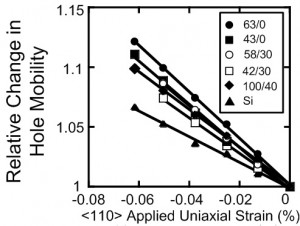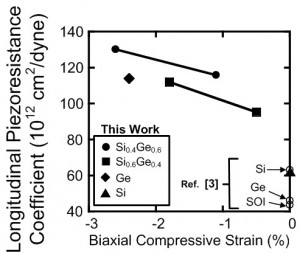Hole Mobility in Asymmetrically Strained SiGe p-MOSFETs
Enhancing carrier transport via a combination of strain and new materials is of interest to improve the performance of future CMOS technology. This work examines the influence of added <110> uniaxial compressive strain on the hole mobility characteristics of biaxial strained-SiGe p-MOSFETs. The added uniaxial strain is introduced via mechanical bending. Figure 1 illustrates that the hole mobility in biaxial compressive-strained-SiGe continues to increase with the application of <110> uniaxial compressive strain. It was also found that the hole mobility in biaxial compressive-strained-SiGe (e.g. 43/0, 42/30, 63/0, 58/30 and 100/40) expresses a greater sensitivity to applied uniaxial compressive strain than Si. The sensitivity to applied uniaxial mechanical strain increases as the amount of biaxial compressive strain in the channel increases. The longitudinal piezoresistance coefficients (πL) are plotted as a function of biaxial strain in Figure 2 to better examine this effect. The piezoresistance coefficients exhibit a substantial increase as the channel biaxial strain increases. However, this effect does not appear to be directly correlated to the channel Ge fraction. The piezoresistance coefficients rise as the nominal channel Ge composition increases from 40% to 60%, but they then decrease when the channel Ge composition reaches 100%. In relaxed Si and Ge, small amounts of applied uniaxial strain (i.e., less than 500 MPa) provide an increase in mobility that is driven by a reduction in the carrier effective mass more so than a modulation in the scattering characteristics [1] [2]. The hole mobility in biaxial compressive strained SiGe exhibits a greater sensitivity to applied mechanical strain than relaxed Si or Ge. This finding suggests that either a larger reduction in the hole effective mass is occurring in the initially biaxial strained material or that the hole mobility is also benefiting from a reduction in scattering. These results indicate that using asymmetric strain in SiGe channels is a promising route to improving the performance of p-MOSFETs.
- Figure 1: The relative mobility enhancement for Si, 43/0, 42/30, 63/0, 58/20, and 100/40 channel p-MOSFETs with applied <110> uniaxial compressive strain. The Y/X notation is used to indicate the channel Ge percentage (Y) and the substrate Ge percentage (X).
- Figure 2: Longitudinal piezoresistance coefficients plotted as a function of biaxial compressive strain. The nominal channel material is indicated on the plot (solid symbols are this work). Piezoresistance coefficients for relaxed bulk Si, Ge, and SOI reported by O. Weber in [3] are also plotted (open symbols).
References
- M. Uchida, Y. Kamakura, and K. Taniguchi, “Performance Enhancement of pMOSFETs Depending on Strain, Channel Direction, and Material,” in SISPAD Tech. Dig., 2005, pp. 315-318. [↩]
- Y. Sun, S. E. Thompson, and T. Nishida, “Physics of strain effects in semiconductors and metal-oxide-semiconductor field-effect transistors,” Journal of App. Phys., vol. 101, no. 10, 2007. pp. 1-22. [↩]
- [3] O. Weber, T. Irisawa, T. Numata, M. Harada, N. Taoka, Y. Yamashita, T. Yamamoto, N. Sugiyama, M. Takenaka, and S. Takagi, “Examination of Additive Mobility Enhancements for Uniaxial Stress Combined with Biaxial Strained Si, Biaxial Strained SiGe, and Ge Channel MOSFETs,” in IEDM Tech. Dig., 2007, pp. 719-722. [↩]

